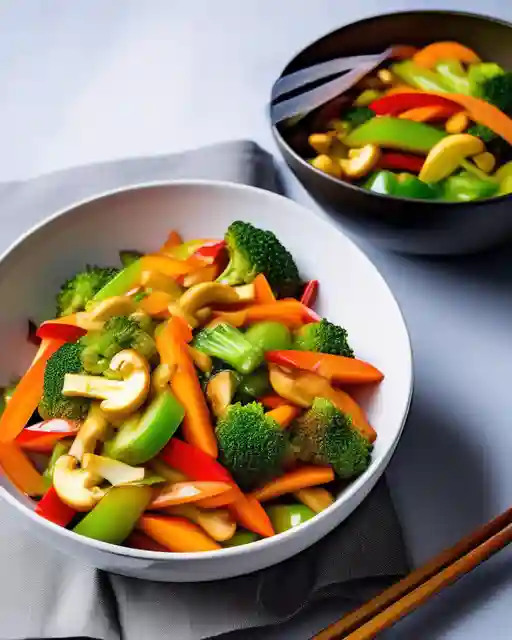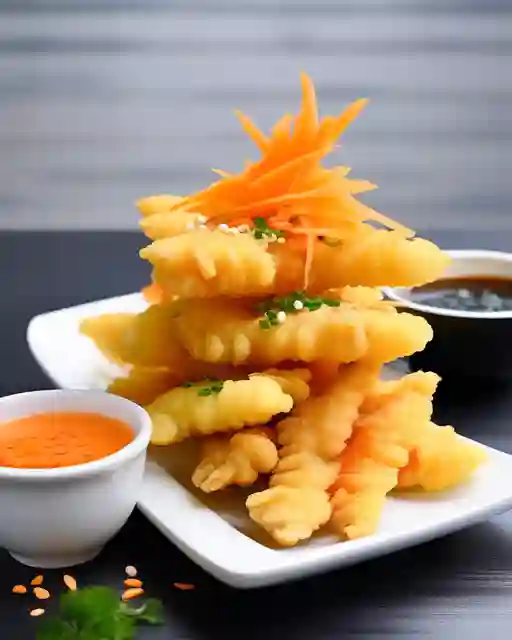41 Easy and Delicious Japanese Vegetarian Options
Updated: 26 Jul 2023
201

Get ready to wow your family and friends with 41 no-fuss vegetarian recipes straight from Japanese home kitchens. This from-scratch guide eliminates meat while maxing out flavors using simple-to-source ingredients you can pick up at the grocery store. Put down the takeout menus and open your cookbooks instead to chef plant-based ramen, tacos, pasta, and more with easy step-by-step anyone can tackle.
Don’t have all day to toil in the kitchen?
No problem – most of these meals come together in under 45 minutes or utilize handy time-saving shortcuts. Master the tasty art of Japanese veggie cooking through dishes specially selected to help rookie home cooks build confidence in cooking sans meat.
With a toolkit of sauces, spices, and pantry item secrets, you’ll feel like you’ve teleported a Japanese granny into your kitchen to help you whip up quick, healthy, and insanely delicious recipes even picky family members will devour.
Most common Ingredients and Flavors in Japanese vegetarian cooking
Japanese veggie dishes highlight fresh produce, tofu, noodles, and rice. Signature flavors include umami-rich sauces like soy sauce, sweet mirin wine, and savory dashi stock. Herbs like ginger, sesame, and shiso also impart a big flavor. Instead of meat, ingredients like fried tofu, mushrooms, and seaweed provide a hearty texture.
Table of Contents
41 Delicious Japanese Vegetarian Options
Vegetable Tofu Dishes

Tofu, or soybean curd, is a versatile ingredient that takes on flavors easily. Get your protein the plant-based way with these easy, meatless tofu recipes:
1. Mapo Tofu
Soft tofu meets spicy and savory Japanese sauce with veggies and spices for a skillet meal.
2. Agedashi Tofu
Crispy fried tofu cubes in hot dashi broth make a tasty appetizer.
3. Tofu Steak
Grilled slices of firm tofu are paired with a sweet and tangy glaze for a hearty entree.
Tofu is a blank canvas ready to be seasoned just like meat would. The dishes above pan-fry, simmer, or grill tofu for appetizers, sides, or meals that even carnivores would enjoy. Absorb the endless possibilities of soybean curd with flavor combos seasoned to Japanese taste.
Vegetable Stir Fries

Stir-frying crisp-tender vegetables in the savory sauce is quick, healthy, and delicious. Try these Japanese-style veggie stir fries:
4. Yasai Itame
- Stir fry mixture of carrots, cabbage, shiitake mushrooms.
- Ginger, garlic, and soy sauce flavor simple ingredients.
- Serve over rice.
5. Kinpira Gobo: Sweet & Spicy Burdock Root
- Sauteed earthy burdock root slivers.
- Tossed in maple syrup, soy sauce, and chili oil.
- Addictive balance of sweet, salty, and spicy.
6. Yasai Nikujaga: Protein-Packed Tofu Stew
- Chunky potatoes, carrots and tofu.
- Simmered in Umami-rich dashi broth.
- Hearty comfort food, meat-free style.
7. Horenso Goma Ae: Sesame Spinach Salad
- Blanched spinach leaves.
- Tossed in creamy sesame seed dressing.
- Nutty, sweet salad side.
The dishes above put a vegetarian twist on Japanese home cooking. Simple, nutritious, and full of cozy appeal.
The key to flavorful stir-fries is high heat to sear in seasonings without overcooking. Slice vegetables thinly so they cook fast. Combine the balanced sweet-savory flavors of Japanese cuisine with a rainbow of healthy plants.
Vegetable Hot Pot Dishes
Hot pots are interactive, communal meals where diners cook bite-sized ingredients in steaming broth at the table. Try these flavorful, plant-based takes on the Japanese hot pot tradition:
8. Shabu Shabu

- Paper-thin slices of tofu, mushrooms, veggies.
- Quickly swished in hot kombu dashi broth.
- Dip in sesame or ponzu sauce.
9. Sukiyaki
- Tofu, vegetables, shirataki noodles.
- Simmered in sweet soy sauce broth.
- Cracked egg adds protein.
The array of vegetables, noodles, and tofu cooks quickly in the simmering broth to be fished out with chopsticks when perfectly tender. Let diners customize tastes with a variety of dipping sauces. Simple, healthy, and fun!
Hearty Japanese Vegetarian Soups
10. Miso Soup: Protein-Packed Soybean Soup

- Umami-rich broth from fermented soybean paste.
- Dashi stock, tofu, wakame seaweed.
- Beloved traditional Japanese comfort food.
11. Yasai Kakejiru: Vegetable Dashi Broth
- Clear dashi broth packed with sautéed veggies.
- Use as a base for noodle bowls and hot pots.
- Extracts natural sweetness from produce.
12. Nameko Mushroom Soup
- Named for its slimy texture.
- The earthy, woodsy, rich mushroom flavor.
- Protein and B vitamins galore.
13. Vegan Ramen: Plant-Based Noodle Bowl
- Vegetable broth with miso and kombu.
- Tofu, mushrooms, and baby bok choy.
- Piping hot bowl to drive away chills.
Warm up with cozy Japanese-style soups minus the meat. Soybeans, vegetables, and mushrooms build hearty broths brimming with comfort. Simple substitutions keep dishes vegan while maximizing flavors.
Scrumptious Japanese Vegetarian Noodles

Slurp up classic Japanese noodle soups and hot broths loaded with vegetables and tofu:
14. Zaru Soba
- Cold soba noodles with dipping sauce.
- Perfect summer dish.
- Top with green onions.
15. Kitsune Udon
- Warm udon noodles in dashi broth.
- Topped with seasoned fried tofu.
- Add soy sauce to taste.
16. Kitsune Udon: Fried Tofu Noodle Soup
- Chewy udon wheat noodles.
- Dashi soup base with soy sauce.
- Topped with crispy fried tofu puffs.
17. Vegan Yakisoba: Plant-Powered Stir-Fry
- Lo mein noodles tossed with julienned vegetables.
- Flavored with sweet-savory veggie-friendly sauces.
- Satisfying slurpy noodle dish, hold the meat.
Trade meat for plant-based umami in these Japanese noodle dishes. Tofu and vegetable proteins pair perfectly with savory sauces coating chewy udon and yakisoba noodles.
Rice Bowls
No Japanese meal is complete without a bowl of steaming rice.
18. Tamago Kake Gohan

- Hot rice topped with egg.
- Mixed with soy sauce.
- Simple, quick breakfast.
19. Vegetable Donburi
- Rice topped with sautéed veggies.
- Feature ingredients by season.
- Customize with toppings.
20. Inari Sushi
- Vinegared sushi rice stuffed in sweet fried tofu pouches.
- Pretty pink parcels.
- Pack for lunch or enjoy at home.
Rice bowls make complete, balanced meals perfect for breakfast, lunch, or dinner. Mix and match fresh vegetables, protein-packed eggs, or tofu over a base of fluffy rice for an easy, meatless meal.
Japanese Vegetarian Street Food Delights
21. Taiyaki: Sweet Red Bean Fish Pastries
- Crunchy, golden fish-shaped pastries.
- Filled with sweet red bean paste.
- Popular hand-held street food snack.
22. Okonomiyaki: Cabbage Veggie Pancakes
- Thick cabbage-studded pancakes.
- Filled with carrots, bean sprouts, tofu instead of meat/seafood.
- Top with savory okonomiyaki sauce and bonito flakes.
23. Imagawayaki: Azuki Bean Filled Treats

- Fluffy round pancakes.
- Sweet red bean paste filling.
- Dust with kinako soybean powder.
Beyond sushi, Japan has inventive vegetarian street food snacks that fill you up. The recipes above forgo meat in favor of plant-based protein from bean and tofu fillings. Pair sweet and savory flavors with tempting crunchy, chewy textures.
Delectable Japanese Vegetarian Sushi Rolls
24. Avocado Maki: Creamy Veggie Roll
- Avocado, cucumber, carrot.
- Wrapped in seaweed and sushi rice.
- Velvety texture with crisp crunch.
25. Kappa Maki: Cool Cucumber Roll
- Thinly sliced cucumbers.
- Topped with sesame seeds.
- Refreshing palate cleanser.
26. Kanpyo Maki: Sweet Pickled Gourd
- Marinated strips of Japanese gourd.
- Rolled up with avocado slices.
- Sweet vinegar notes.
27. Shiitake Nigiri: Meaty Mushroom Bites
- Thick-cut shiitake mushroom.
- Atop small, pressed rice balls.
- Savory umami-rich flavor.
Skip the seafood and load up these Japanese veggie sushi rolls instead. Avocado, cucumber, and mushrooms offer refreshing flavors and textures. Simple substitutions keep the sushi experience meat and fish-free.
Tempura
Tempura is vegetables or seafood dipped in a light batter and fried to golden perfection.
28. Assorted Vegetable Tempura

- Thinly slice carrots, mushrooms, sweet potatoes.
- Dip in tempura batter and fry quickly.
- Serve with tempura dipping sauce.
29. Sweet Potato Tempura
- Fresh sweet potato slices.
- Coated in crispy tempura batter.
- Simple pumpkin-colored fritters.
The secret to keeping veggie tempura light is a well-made batter and high-heat oil to fry foods fast without absorbing much grease. Eat right away while hot and crispy with sweet-and-savory dipping sauce.
Salads and Sides
Cool, crunchy salads and sides balance hearty Japanese meals. Try these flavor-packed recipes:
30. Sunomono
- Cucumbers or seaweed soaked in sweet vinegar.
- A refreshing contrast to rich foods.
31. Goma-ae
- Blanched veggies tossed in creamy sesame dressing.
- Green beans or eggplant work well.
32. Takuan
- Japanese pickled daikon radish.
- Bright yellow and crunchy.
- Makes rice and noodles shine.
Japanese sides highlight the unique flavors of seasonal produce. Quick pickled vegetables offer a tasty tang, crunchy texture, and visionary yellow, white, or green hues to balance any plate.
Tantalizing Japanese Vegetarian Sweets
33. Wagashi: Miniature Artful Bites
- Intricately crafted bite-sized Japanese confections.
- Flora and fauna shapes made from rice flour and beans.
- Sweetened just enough to balance natural flavors.
34. Ichigo Daifuku: Strawberry Mochi Cakes
- Soft and chewy mochi rice cakes.
- Wrapped around sweet fresh strawberry fillings.
- The perfect balance of tangy fruit and neutral mochi.
35. Dorayaki: Fluffy Sweet Pancakes
- Fluffy palm-sized red bean pancakes.
- Sweet azuki bean filling centers rich stacks.
- Moreish comfort food treat.
These beautiful Japanese sweets offer edible art. Natural shapes and colors mimic nature while sweet flavors balance.
Desserts
Indulge your sweet tooth with these scrumptious Japanese desserts:
36. Fruit Anmitsu
- Fruit-topped jelly cubes dressed in sweetened milk.
- Black sugar syrup lends a rich molasses flavor.
37. Daifuku Mochi
- Soft mochi rice cakes stuffed with sweet bean paste.
- Strawberry and chocolate flavors too.
38. Dango Dumplings

- Bite-sized sticky rice balls skewered on sticks.
- Sweet with salty-sweet soy sauce for dipping.
The perfect finale to a Japanese vegetarian meal. The recipes above combine sweet fruits, floral essences, and softly chewy textures made from rice and beans. Simple handheld sweets are easily portioned for parties or afternoon tea.
Drinks
Wash down your delicious meatless meal with these refreshing beverages:
39. Genmaicha Tea
- Japanese green tea blended with roasted rice.
- Nutty, buttery flavor without milk.
- Low caffeine for any time of day.
40. Soy Milk
- Creamy non-dairy milk made from soaked soybeans.
- Protein-rich way to start the day.
- Use for smoothies or curries.
41. Amazake
- Thick, sweet fermented rice drink.
- Creamy texture like eggnog.
- Winter warmer alcohol-free toddy.
Japan has flavorful plant-based drinks for everyone. Creamy soy milk provides protein, while nutty Genmaicha tea and sweet amazake offer caffeine-free comfort. Pair with dessert or enjoy alone!
Final Thoughts
From tofu tacos to mushroom ramen bowls, this mouthwatering guide equips you to recreate Japanese veggie fare with supermarket staples. Pack away meatless lunches featuring edible origami pouches stuffed with rice and pickles.
Stage an interactive dinner party around a bubbling hot pot filled with udon noodles and vegetable slices. Even novice cooks can master seaweed-wrapped sushi rolls and crispy fritters thanks to easy step-by-step instructions.
Leaving animal products off the menu doesn’t mean sacrificing the iconic flavors, artistry and innovation Japanese cuisine is renowned for. Reimagine this food-obsessed island nation’s greatest hits, hold the fish and meat.
FAQs
Are there vegetarian options in Japan?
Yes, there are many vegetarian options in Japan. Traditional Japanese cuisine relies heavily on vegetables, tofu, mushrooms, and grains. You can find vegetarian sushi, noodles dishes, hot pots, salads, and more. Major cities like Tokyo and Kyoto also have lots of vegetarian restaurants to choose from.
How to ask for vegetarian Japanese?
In Japanese, use “vegetarian” (ベジタリアン) or “I don’t eat meat” (肉を食べません) when ordering. You can also ask if a dish can be made without meat, fish, etc. Know common animal ingredients like dashi (fish stock) so you can request vegetable stock instead.
Are most Japanese people vegetarian?
No, only a small percentage of Japanese people are vegetarian. However, most people regularly eat vegetarian meals as vegetables, tofu, noodles, and rice are staples of the traditional diet.
Does Tokyo have food options for pure vegetarians?
Yes, Tokyo has many restaurants catering specifically to vegetarians and vegans. Neighborhoods like Asakusa have many vegetable-focused eateries. Department stores and festivals also offer pure vegetarian fare. You’ll find plenty of choices.
Which country eats the most vegetarian food?
India has the highest percentage of vegetarians in the world, with nearly 40% of the population eating a strictly vegetarian diet.
Is Bread in Japan vegetarian?
Much of the bread sold in Japan, including common varieties like shoku-pan (white bread), is vegetarian. Some sweet pieces of bread or other flavored varieties may contain milk, butter, or egg. When in doubt, check with staff or look for a vegetarian label.
Is sushi considered vegetarian?
Strict vegetarians avoid sushi containing fish or other seafood. Many vegetarian sushi options exist, such as cucumber rolls (kappa maki) or natto rolls. Order vegetarian sushi by requesting no fish ingredients.
Is most sushi vegetarian?
No, most types of sushi contain fish, seafood or sometimes meat products. Vegetarian sushi makes up a smaller subset of options. Verify sushi ingredients when ordering to get vegetarian items.
What percentage of Japan is vegetarian?
Rough estimates suggest only 3-5% of Japanese are vegetarian. However trends show interest in vegetarianism growing. So more plant-based options exist now than ever before.
Please Write Your Comments